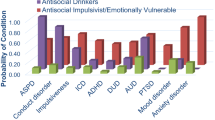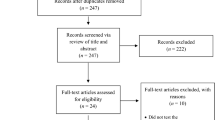Abstract
This study examined whether distinct subgroups could be identified among a sample of non-treatment-seeking problem and pathological/disordered gamblers (PG) using Blaszczynski and Nower’s (Addiction 97:487–499, 2002) pathways model (N = 150, 50% female). We examined coping motives for gambling, childhood trauma, boredom proneness, risk-taking, impulsivity, attention-deficit/hyperactivity disorder (ADHD), and antisocial personality disorder as defining variables in a hierarchical cluster analysis to identify subgroups. Subgroup differences in gambling, psychiatric, and demographic variables were also assessed to establish concurrent validity. Consistent with the pathways model, our analyses identified three gambling subgroups: (1) behaviorally conditioned (BC), (2) emotionally vulnerable (EV), and (3) antisocial-impulsivist (AI) gamblers. BC gamblers (n = 47) reported the lowest levels of lifetime depression, anxiety, gambling severity, and interest in problem gambling treatment. EV gamblers (n = 53) reported the highest levels of childhood trauma, motivation to gamble to cope with negative emotions, gambling-related suicidal ideation, and family history of gambling problems. AI gamblers (n = 50) reported the highest levels of antisocial personality disorder and ADHD symptoms, as well as higher rates of impulsivity and risk-taking than EV gamblers. The findings provide evidence for the validity of the pathways model as a framework for conceptualizing PG subtypes in a non-treatment-seeking sample, and underscore the importance of tailoring treatment approaches to meet the respective clinical needs of these subtypes.
Similar content being viewed by others
Notes
Other runs using alternative clustering algorithms are available from the first author.
Raw scores are presented to facilitate comparison with other studies.
References
Anderson, G., & Brown, R. I. F. (1984). Real and laboratory gambling, sensation seeking and arousal: toward a Pavlovian component in general theories of gambling and gambling addictions. British Journal of Psychology, 75, 401–411.
Baumeister, R. F., Vohs, K. D., & Tice, D. M. (2007). The strength model of self-control. Current Directions in Psychological Science, 16, 396–403.
Bernstein, D. P., & Fink, L. (1998). Childhood trauma questionnaire: A retrospective self-report manual. San Antonio, TX: Psychological Corporation.
Blaszczynski, A., & Nower, L. (2002). A pathways model of problem and pathological gambling. Addiction, 97, 487–499.
Blaszczynski, A., Steel, Z., & McConaghy, N. (1997). Impulsivity in pathological gambling: The antisocial impulsivist. Addiction, 92, 75–87.
Bonnaire, C., Bungener, C., & Varescon, I. (2009). Subtypes of French pathological gamblers: Comparison of sensation seeking, alexithymia and depression scores. Journal of Gambling Studies, 25, 455–471.
Connors, C. K., Erhardt, D., & Sparrow, E. (1999). Conners’ adult ADHD rating scales (CAARS). North Tonawanda, NY: Multi-Health Systems.
Ferris, J., & Wynne, H. (2001). The Canadian Problem Gambling Index: Final Report. Ottawa: Canadian Center on Substance Abuse.
First, M. B., Spitzer, R. L., Gibbon, M., & Williams, J. B. W. (1996). Structured clinical interview for DSM-IV Axis I disorders, patient edition (SCID-P). New York: New York State Psychiatric Institute.
Gerstein, D., Murphy, S., Toce, M., Hoffman, J., Palmer, A., Johnson, R., et al. (1999). Gambling impact and behavior study. Chicago: University of Chicago.
Gonzalez-Ibanez, A., Aymani, M. N., Jimenez, S., Domenech, J. M., Granero, R., & Lourido-Ferreira, M. R. (2003). Psychological Reports, 93, 707–716.
Granero, R., Fernández-Aranda, F., Aymamí, N., Gómez-Peña, M., Fagundo, A. B., Sauchelli, S., et al. (2015). Subtypes of pathological gambling with concurrent illegal behaviors. Journal of Gambling Studies, 31(4), 1161–1178.
Hair, J. F., Jr., & Black, W. C. (2000). Cluster analysis. In L. G. Grimm & P. R. Yarnold (Eds.), Reading and understanding more multivariate statistics (pp. 147–205). Washington, DC: American Psychological Association.
Hodgins, D. C., & el-Guebaly, N. (2000). Natural and treatment-assisted recovery from gambling problems: A comparison of resolved and active gamblers. Addiction, 95(5), 777–789.
Hodgins, D. C., & el-Guebaly, N. (2010). The influence of substance dependence and mood disorders on outcome from pathological gambling: Five year follow. Journal of Gambling Studies, 26(1), 117–127.
Jacobs, D. F. (1986). A general theory of addictions: a new theoretical model. Journal of Gambling Behavior, 2, 15–31.
Jobes, D. A. (2006). Managing suicidal risk: A collaborative approach. New York: The Guilford Press.
Joiner, T. E., Walker, R. L., Rudd, M. D., & Jobes, D. A. (1999). Scientizing and routinizing the assessment of suicidality in outpatient practice. Professional Psychology: Research and Practice, 30, 447–453.
Knezevic, B., & Ledgerwood, D. M. (2012). Gambling severity, impulsivity, and psychopathology: Comparison of treatment- and community-recruited pathological gamblers. American Journal on Addictions, 21(6), 508–515.
Ledgerwood, D. M., Alessi, S. M., Phoenix, N., & Petry, N. M. (2009). Behavioral assessment of impulsivity in pathological gamblers with and without substance use disorder histories versus healthy controls. Drug and Alcohol Dependence, 105, 89–96.
Ledgerwood, D. M., Arfken, C. L., Wiedemann, A., Bates, K. E., Holmes, D., & Jones, L. (2013). Who goes to treatment? Predictors of treatment initiation among gambling helpline callers. American Journal on Addictions, 22(1), 33–38.
Ledgerwood, D. M., & Petry, N. M. (2006). Psychological experience of gambling and subtypes of pathological gamblers. Psychiatry Research, 144, 17–27.
Ledgerwood, D. M., & Petry, N. M. (2010). Subtyping pathological gamblers based on impulsivity, depression and anxiety. Psychology of Addictive Behaviors, 24(4), 680–688.
Lesieur, H. R. (2001). Cluster analysis of types of inpatient pathological gamblers. Dissertation Abstracts International, 62B, 2065.
Lister, J. J., Milosevic, A., & Ledgerwood, D. M. (2015a). Psychological characteristics of problem gamblers with and without mood disorder. Canadian Journal of Psychiatry, 60(8), 369–376.
Lister, J. J., Milosevic, A., & Ledgerwood, D. M. (2015b). Personality traits of problem gamblers with and without alcohol dependence. Addictive Behaviors, 47, 48–54.
Lobo, D. S. S., Quilty, L. C., Martins, S. S., Tavares, H., Vallada, H., Kennedy, J. L., et al. (2014). Pathological gambling subtypes: a comparison of treatment-seeking and non-treatment-seeking samples from Brazil and Canada. Addictive Behaviors, 39(7), 1172–1175.
Milligan, G. W., & Cooper, M. C. (1988). A study of standardization of variables in cluster analysis. Journal of Classification, 5, 181.
Milosevic, A., & Ledgerwood, D. M. (2010). The subtyping of pathological gambling: A comprehensive review. Clinical Psychology Review, 30(8), 988–998.
Mooi, E., & Sarstedt, M. (2011). Understanding cluster-analysis. In E. Mooi & M. Sarstedt (Eds.), A concise guide to market research: The process, data, and methods using IBM SPSS statistics (pp. 259–283). Berlin: Springer.
Najavits, L. M., Smylie, D., Johnson, K., Lung, J., & Classen, C. (2013). Seeking safety therapy for pathological gambling and PTSD: A pilot outcome study. Journal of Psychoactive Drugs, 45, 10–16.
Petry, N. M., & Casarella, T. (1999). Excessive discounting of delayed rewards in substance abusers with gambling problems. Drug and Alcohol Dependence, 56(1), 25–32.
Sharpe, L. (2002). A reformulated cognitive–behavioral model of problem gambling: a biopsychosocial perspective. Clinical Psychology Review, 22, 1–25.
Steel, Z., & Blaszczynski, A. (1996). The factorial structure of pathological gambling. Journal of Gambling Studies, 12, 3–20.
Stewart, S. H., & Zack, M. (2008). Development and psychometric evaluation of a three dimensional Gambling Motives Questionnaire. Addiction, 103, 1110–1117.
Stewart, S. H., Zack, M., Collins, P., Klein, R. M., & Fragopoulos, F. (2008). Subtyping pathological gamblers on the basis of affective motivations for gambling: Relations to gambling problems, drinking problems, and affective motivations for drinking. Psychology of Addictive Behaviors, 22, 257–268.
Suomi, A., Dowling, N. A., & Jackson, A. C. (2014). Problem gambling subtypes based on psychological distress, alcohol abuse and impulsivity. Addictive Behaviors, 39(12), 1741–1745.
Tellegan, A. (2000). Manual for the multidimensional personality questionnaire. Minneapolis: University of Minnesota Press.
Turner, N. E., Jain, U., Spence, W., & Zangeneh, M. (2008). Pathways to pathological gambling: Component analysis of variables related to pathological gambling. International Gambling Studies, 8, 281–298.
Vachon, D. D., & Bagby, R. M. (2009). Pathological gambling subtypes. Psychological Assessment, 21, 608–615.
Valleur, M., Codina, I., Vénisse, J. L., Romo, L., Magalon, D., Fatséas, M., et al. (2016). Towards a validation of the three pathways model of pathological gambling. Journal of Gambling Studies, 32(2), 751–771.
Waluk, O. R., Youssef, G. J., & Dowling, N. A. (2016). The relationship between problem gambling and attention deficit hyperactivity disorder. Journal of Gambling Studies, 32(2), 591–604.
Whiteside, S. P., & Lynam, D. R. (2001). The five factor model and impulsivity: Using a structural model of personality to understand impulsivity. Personality and Individual Differences, 30(4), 669–689.
Yim, O., & Ramdeen, K. T. (2015). Hierarchical cluster analysis: Comparison of three linkage measures and application to psychological data. The Quantitative Methods for Psychology, 11(1), 8–21.
Acknowledgements
This research was supported by the Ontario Problem Gambling Research Centre, the Joe Young Sr–Helene Lycaki Funds from the State of Michigan, and the Detroit Wayne Mental Health Authority. Aleks Milosevic collected the data during his doctoral studies at the University of Windsor Department of Psychology. We thank Ron Frisch for his assistance with this study. All authors contributed to writing and data analysis processes during the preparation of this manuscript. All authors have read and approved of this manuscript. There are no conflicts of interest to report.
Author information
Authors and Affiliations
Corresponding authors
Rights and permissions
About this article
Cite this article
Moon, M., Lister, J.J., Milosevic, A. et al. Subtyping Non-treatment-seeking Problem Gamblers Using the Pathways Model. J Gambl Stud 33, 841–853 (2017). https://doi.org/10.1007/s10899-016-9658-y
Published:
Issue Date:
DOI: https://doi.org/10.1007/s10899-016-9658-y




